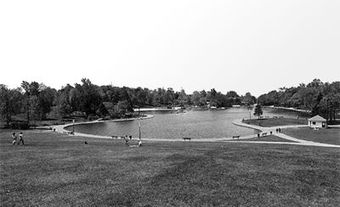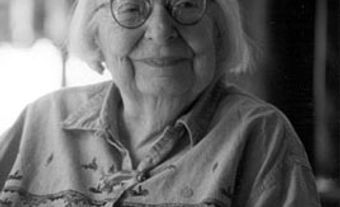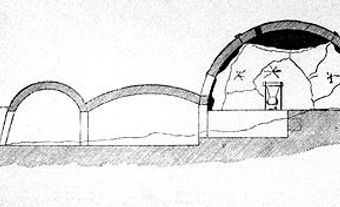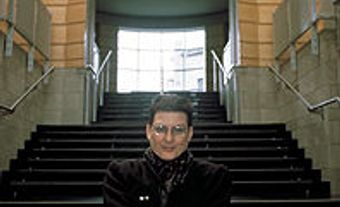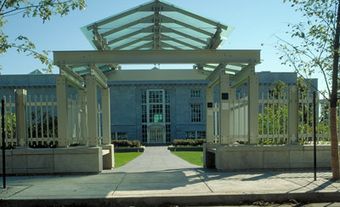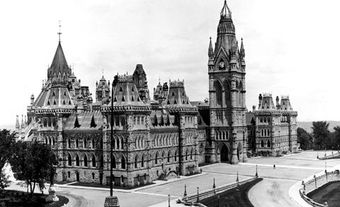Peter Cardew, architect (born 8 June 1939 in Guildford, England; died 26 October 2020 in Vancouver, BC). Cardew immigrated to Canada in 1966 and established his own architectural firm in Vancouver in 1980. Cardew’s architectural projects received critical acclaim and he was the recipient of numerous awards during his career, including the Royal Architectural Institute of Canada’s Gold Medal in 2012. (See also Architecture.)
Education and Early Career
Peter Cardew attended Kingston Polytechnic (now Kingston University London) in, England (1958-64), receiving his Diploma in Architecture in 1965. He worked in Stuttgart, Germany (1961-62), and briefly in England before immigrating to Canada in 1966. (See also Immigration to Canada.)
Rhone & Irelade Architects
In 1967, Cardew joined Rhone & Iredale Architects in Vancouver, British Columbia. He became a partner in 1974. In his 13 years with the firm he was project team designer for several award-winning buildings, including the Lignum Forestry Building (1977), the Crown Life Tower (1980) and False Creek townhouses (1980). (See also Architecture.)
Peter Cardew Architects
In 1980, Cardew established his own practice, Peter Cardew Architects in Vancouver, British Columbia. While modern materials and technology inspired the forms and volumes of his work, he relied on the straightforward detailing of vernacular building to enhance its accessibility. Cardew also showed a remarkable capacity in his work to link building and site through design. Examples the Lach Klan School Industrial Arts Shop (Dolphin Island, northwest British Columbia, 1988); and the Stone Band School (Chilcotin Region, north central British Columbia, 1991). (See also Architecture.)
Major Works
In 1992, Peter Cardew Architects, in partnership with a British firm, completed New Bridge Square in Wiltshire, United Kingdom, the firm's first major international project and a significant foray into large-scale public work. Nonetheless, Cardew's more modest projects in and around Vancouver continue to receive the most critical recognition. (See also Architecture.)
The Stein Medical Clinic (2005) in Vancouver captures a triangular 122-square-metre remnant of the ground floor of an office tower and demonstrates the late architect's considerable skill in composing well-proportioned spaces in constrained sites. The project is typical of Cardew's minimalistic design approach: simple, subtly dramatic compositions of planes and volumes; hard surfaces enlivened by lighting; a restrained material palette; and expressive but sparing detailing.
This exacting design approach is evident in Cardew's residential projects such as the Garden Wall House (2006), an infill house in the back garden of a heritage manor, and the LeBlanc House (2007), a renovation of a post-war split-level bungalow. The Garden Wall House, a slender bar-shaped building composed of six rooms and three courtyards, is carefully sited to maximize access to light and outdoor space for the new dwelling while maintaining the openness of the original manor lot. The garden wall itself ensures the privacy of both houses and emphasizes the site's urban character.
In the LeBlanc House, strategic incisions reconfigure the split-level bungalow's floorplan while maintaining the clarity of its original form. The dropped ceiling at the split-level line is peeled back and a vaulted skylight is added, bringing light into the main living spaces. Playful shifts in scale create a spatial narrative through the house; for example, the ceiling in the foyer is lowered while the front door is over-sized.
The Garden Wall House, LeBlanc House and Saturna Island House (2002) all show Cardew's careful attention to detail: sharp corners and reveals heighten the effect of juxtaposed volumes and materials. This detailing, despite (or because of) its aesthetic simplicity, requires a high degree of precision in construction. Cardew prioritized quality workmanship in his projects, often seeking out specific builders and tradespeople. The LeBlanc House, for example, was realized in close collaboration with builder John Mason, a London-trained architectural graduate.
Awards
Peter Cardew Architects has won both national and international awards for its work. Projects recognized by a Canadian Architect Award of Excellence include the O'Sullivan-Donaldson Residence, Lion's Bay, BC (1980); the Lach Klan School Industrial Arts Shop (1988); the Stone Band School (1990); the Morris and Helen Belkin Art Gallery (1994); the Lignum Offices and Forestry Centre addition (1996) and the Garden Wall House (2006).
Peter Cardew’s architectural works have also garnered numerous awards, including three Progressive Architecture Awards. In 1999 he was awarded the Royal Architectural Institute of Canada’s Governor General's Medal for Architecture for the Belkin Art Gallery. He has received the Architectural Institute of British Columbia’s Lieutenant Governor’s Medal for Architecture for a private residence in West Vancouver (1999), the Belkin Art Gallery (1999), the Odlum Drive Live-Work Studios (1999) and the Stein Medical Clinic (2005).
Legacy
In addition to his architectural practice, Peter Cardew taught and lectured extensively in North and South America and Europe. (See also Architectural Education.) He also served as chairman of the City of Vancouver Urban Design Panel (see Urban Design). A retrospective exhibition and monograph of his work, Peter Cardew: Ordinary Buildings, was presented by the Charles H. Scott Gallery, Emily Carr University of Art and Design in 1996.
Honours and Awards
- Member, Royal Architectural Institute of Canada (1967)
- Member, Architectural Institute of British Colombia (1967)
- Academician in the Art of Architecture, Royal Canadian Academy of Arts (1983)
- Gold Medal, Royal Architecture Institute of Canada (2012)

 Share on Facebook
Share on Facebook Share on X
Share on X Share by Email
Share by Email Share on Google Classroom
Share on Google Classroom



